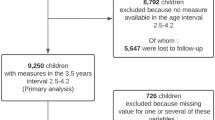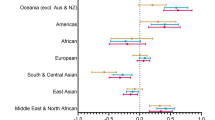Abstract
OBJECTIVES:
Childhood obesity is now recognized as a global public health issue. Social patterning of obesity, consistent with the theory of epidemiologic transition, has not been well described in children, and the limited research has focused on developed settings. The aim of this study was to describe the relationship between childhood obesity and household income using objective measures of adiposity and to explore how this relationship differs across levels of country human development.
METHODS:
The International Study of Childhood Obesity, Lifestyle and the Environment (ISCOLE) was a multi-national cross-sectional study conducted in 12 urban/suburban study sites that represented all inhabited continents and wide ranges of development. ISCOLE collected objectively measured height, body mass and percentage body fat in 7341 10-year-old children. Multi-level random-effects models were used to examine income gradients in several obesity measures.
RESULTS:
The mean age of the children was 10.4 years, and 12.6% were obese, ranging from 5.4% (Finland) to 23.8% (China). For both boys and girls, obesity prevalence, body fat percentage and body mass index (BMI) z-score increased linearly with higher income at lower levels of development (all P for trend ⩽0.0012), but decreased linearly with higher income at higher levels of development (all P for trend ⩽0.0003). Country human development explained 75% of the variation in the country-specific income–obesity relationships (r=−0.87, P=0.0003).
CONCLUSIONS:
Results are consistent with the theory of epidemiologic transition. Global efforts to control obesity must account for socioeconomic factors within a country’s context. Future research should seek to understand global socioeconomic patterns in obesity-related lifestyle behaviors.
This is a preview of subscription content, access via your institution
Access options
Subscribe to this journal
We are sorry, but there is no personal subscription option available for your country.
Buy this article
- Purchase on Springer Link
- Instant access to full article PDF
Prices may be subject to local taxes which are calculated during checkout



Similar content being viewed by others
References
World Health Organization. Consultation on Obesity. Obesity: preventing and managing the global epidemic. Report of a WHO consultation. World Health Organ Tech Rep Ser 2000; 894: i–xii, 1–253.
Ng M, Fleming T, Robinson M, Thomson B, Graetz N, Margono C et al. Global, regional, and national prevalence of overweight and obesity in children and adults during 1980-2013: a systematic analysis for the Global Burden of Disease Study 2013. Lancet 2014; 384: 766–781.
Omran AR . The epidemiologic transition. A theory of the epidemiology of population change. Milbank Mem Fund Q 1971; 49: 509–538.
Sobal J, Stunkard AJ . Socioeconomic status and obesity: a review of the literature. Psychol Bull 1989; 105: 260–275.
Monteiro CA, Moura EC, Conde WL, Popkin BM . Socioeconomic status and obesity in adult populations of developing countries: a review. Bull World Health Organ 2004; 82: 940–946.
McLaren L . Socioeconomic status and obesity. Epidemiol Rev 2007; 29: 29–48.
Dinsa GD, Goryakin Y, Fumagalli E, Suhrcke M . Obesity and socioeconomic status in developing countries: a systematic review. Obes Rev 2012; 13: 1067–1079.
Shrewsbury V, Wardle J . Socioeconomic status and adiposity in childhood: a systematic review of cross-sectional studies 1990-2005. Obesity 2008; 16: 275–284.
Due P, Damsgaard MT, Rasmussen M, Holstein BE, Wardle J, Merlo J et al. Socioeconomic position, macroeconomic environment and overweight among adolescents in 35 countries. Int J Obes 2009; 33: 1084–1093.
McEniry M . Early-life conditions and older adult health in low- and middle-income countries: a review. J Dev Orig Health Dis 2013; 4: 10–29.
Brisbois TD, Farmer AP, McCargar LJ . Early markers of adult obesity: a review. Obes Rev 2012; 13: 347–367.
Raphael D . Poverty in childhood and adverse health outcomes in adulthood. Maturitas 2011; 69: 22–26.
Tamayo T, Christian H, Rathmann W . Impact of early psychosocial factors (childhood socioeconomic factors and adversities) on future risk of type 2 diabetes, metabolic disturbances and obesity: a systematic review. BMC Public Health 2010; 10: 525.
Gidding SS, Bao W, Srinivasan SR, Berenson GS . Effects of secular trends in obesity on coronary risk factors in children: the Bogalusa Heart Study. J Pediatr 1995; 127: 868–874.
Daniels SR, Arnett DK, Eckel RH, Gidding SS, Hayman LL, Kumanyika S et al. Overweight in children and adolescents: pathophysiology, consequences, prevention, and treatment. Circulation 2005; 111: 1999–2012.
Katzmarzyk PT, Barreira TV, Broyles ST, Champagne CM, Chaput JP, Fogelholm M et al. The International Study of Childhood Obesity, Lifestyle and the Environment (ISCOLE): design and methods. BMC Public Health 2013; 13: 900.
United Nations Development Programme. Human Development Report 2011. Available at http://www.undp.org/content/dam/undp/library/corporate/HDR/2011%20Global%20HDR/English/HDR_2011_EN_Complete.pdf (accessed on 4 August 2014).
de Onis M, Onyango AW, Borghi E, Siyam A, Nishida C, Siekmann J . Development of a WHO growth reference for school-aged children and adolescents. Bull World Health Organ 2007; 85: 660–667.
Rubin DB . Multiple Imputation for Nonresponse in Surveys. J Wiley & Sons: New York, NY, USA, 1987.
Kenward MG, Roger JH . Small sample inference for fixed effects from restricted maximum likelihood. Biometrics 1997; 53: 983–997.
Drewnowski A, Popkin BM . The nutrition transition: new trends in the global diet. Nutr Rev 1997; 55: 31–43.
Katzmarzyk PT, Mason C . The physical activity transition. J Phys Act Health 2009; 6: 269–280.
Drewnowski A, Specter S . Poverty and obesity: the role of energy density and energy costs. American Journal of Clinical Nutrition 2004; 79: 6–16.
Gordon-Larsen P, Nelson MC, Page P, Popkin BM . Inequality in the built environment underlies key health disparities in physical activity and obesity. Pediatrics 2006; 117: 417–424.
Loukaitou-Sideris A, Eck JE . Crime prevention and active living. Am J Health Promot 2007; 21: 380–389 iii.
Yusuf S, Rangarajan S, Teo K, Islam S, Li W, Liu L et al. Cardiovascular risk and events in 17 low-, middle-, and high-income countries. N Engl J Med 2014; 371: 818–827.
Rivera JA, de Cossio TG, Pedraza LS, Aburto TC, Sanchez TG, Martorell R . Childhood and adolescent overweight and obesity in Latin America: a systematic review. Lancet Diabetes Endocrinol 2014; 2: 321–332.
Marmot M . Social determinants of health inequalities. The Lancet 2005; 365: 1099–1104.
World Health Organization, Commission on Social Determinants of Health. A conceptual framework for action on the social determinants of health 2007. Available at http://www.who.int/social_determinants/resources/csdh_framework_action_05_07.pdf (accessed on 2 July 2008).
Neuman M, Kawachi I, Gortmaker S, Subramanian SV . Urban-rural differences in BMI in low- and middle-income countries: the role of socioeconomic status. Am J Clin Nutr 2013; 97: 428–436.
Acknowledgements
We thank the ISCOLE External Advisory Board and the ISCOLE participants and their families who made this study possible. A membership list of the ISCOLE Research Group and External Advisory Board is included in Katzmarzyk et al. (this issue). ISCOLE was funded by The Coca-Cola Company. MF has received a research grant from Fazer Finland. RK has received a research grant from Abbott Nutrition Research and Development.
Author information
Authors and Affiliations
Consortia
Corresponding author
Ethics declarations
Competing interests
MF has received an honorarium for speaking for Merck. AK has been a member of the Advisory Boards of Dupont and McCain Foods. VM is a member of the Scientific Advisory Board of Actigraph and has received an honorarium for speaking for The Coca-Cola Company. TO has received an honorarium for speaking for The Coca-Cola Company. The remaining authors declare no conflict of interest.
Rights and permissions
About this article
Cite this article
Broyles, S., Denstel, K., Church, T. et al. The epidemiological transition and the global childhood obesity epidemic. Int J Obes Supp 5 (Suppl 2), S3–S8 (2015). https://doi.org/10.1038/ijosup.2015.12
Published:
Issue Date:
DOI: https://doi.org/10.1038/ijosup.2015.12
This article is cited by
-
Research methodology used in the 50 most cited articles in the field of pediatrics: types of studies that become citation classics
BMC Medical Research Methodology (2020)
-
Burden of obesity in the Eastern Mediterranean Region: findings from the Global Burden of Disease 2015 study
International Journal of Public Health (2018)
-
Socioeconomic status and dietary patterns in children from around the world: different associations by levels of country human development?
BMC Public Health (2017)



